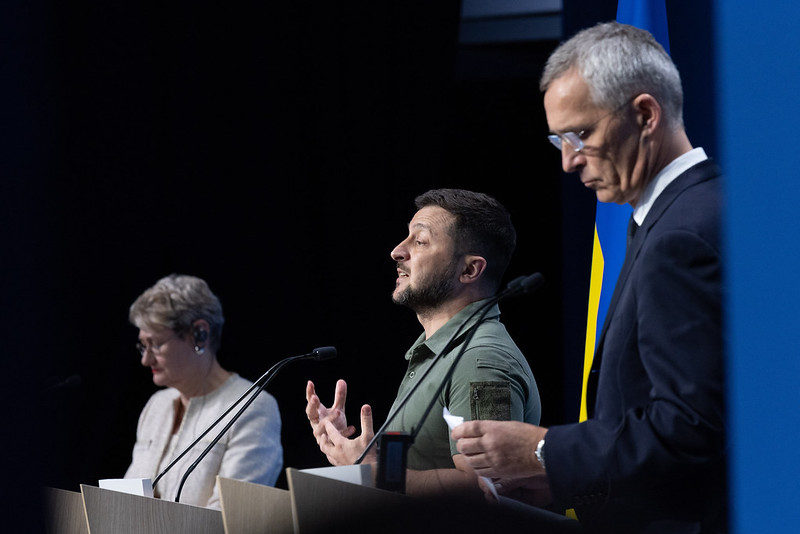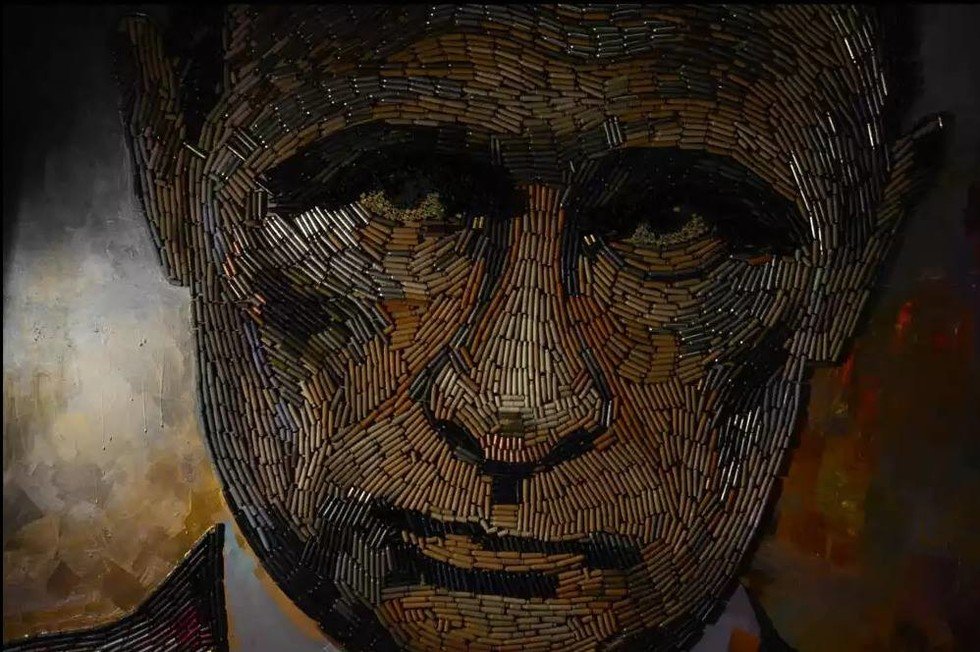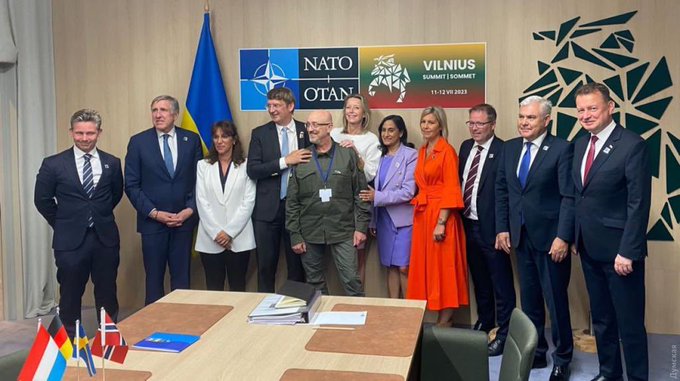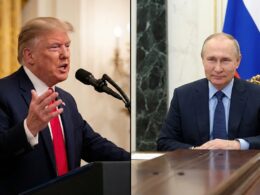Ukraine did not get the "political signal" that it hoped for -- an invitation to the Alliance -- at the NATO summit in Vilnius on 11-12 July. However, the minimum program was achieved: it received more than it got in Bucharest in 2008 and more than from the Budapest Memorandum of 1994.
As a draft final communique containing conditions for such a future invitation was leaked on the first day, Zelenskyy slammed the Allies for their indecisiveness. But on the second day, he changed the tone, saying that the result of the summit is not perfect, but good. Here are seven things that the summit in Lithuania changed for Ukraine-NATO relations.
1. Bucharest+: NATO now promises to invite Ukraine but doesn't say when
NATO will invite Ukraine to join the Alliance when “Allies agree and conditions are met,” according to the NATO Vilnius Summit Communiqué issued on 11 July by NATO leaders. The Alliance reaffirmed that Ukraine’s future is in NATO, and said Ukraine moved beyond the Membership Action Plan, but the country still needs additional reforms. The declaration did not provide a timeline for Ukraine’s accession to NATO and clear conditions for its membership.
Ukrainian lawmaker Oleksiy Honcharenko told that there were huge arguments about whether the final communique would invite Ukraine until the last moment, and there was a risk that the word "invitation" would have been left out in the first place. Eastern European nations together with the hosting country Lithuania, as well as France, Italy, and the UK insisted on NATO inviting Ukraine now, while Germany and USA held conservative positions.
Ukraine's Foreign Minister Kuleba said that the United States and Germany are the most conservative about Ukraine's future membership in NATO.
However, according to him, it was Washington that played a decisive role in making "the word 'invitation' appear in the text of the communiqué at all."
The NATO declaration mentioning a future invitation for Ukraine takes Ukraine-NATO relations to a new level, according
to foreign affairs expert Alyona Hetmanchuk. If at the 2008 NATO Summit in Bucharest, most Allies did not believe what they themselves had written down ("Ukraine and Georgia will become NATO members"), now the possibility of Ukraine's NATO membership is no longer opposed by even the biggest skeptics.
The question is when, and Ukraine and the Allies have contradicting visions, Hetmanchuk writes. The Allies see the issues of military support to Ukraine and Ukraine's entrance to NATO as absolutely unrelated, apart from the latter potentially being able to provoke more war, not end it. Meanwhile, Kyiv sees Ukraine's movement to NATO as being able end the war, not only prevent further aggression.
However, this position of the Allies applies only to the present. In the future, NATO is seen as being able to prevent Russian aggression against Ukraine, and the scenario of West/East Germany comes up more and more often: when NATO will be prepared to accept Ukraine before it restores sovereignty over all Russian-occupied territories, Hetmanchuk writes.
As well, Kyiv and Allies have two diametrically opposing visions when it comes to the question of an invitation to NATO and the start of the accession process, according to the expert. While Kyiv believes that the invitation could happen during the war and had built its campaign around this goal, the Allies do not these two stages, having learned after Bucharest-2008 that political declarations do not offer protections.
This is why many in NATO spoke about the word "invitation" in the final declaration as a breakthrough; two months before the summit, it elicited a flurry of irritation in many NATO capitals.
In any case, the summit in Vilnius is seen as a "bridge" to the upcoming summit in Washington DC, scheduled for 2024, where Ukraine will try to achieve what was not achieved now.
2. Budapest+: G7 launches framework agreement on "security commitments"
During the NATO summit in Vilnius, the G7 group of countries agreed on a framework document on security commitments for Ukraine at the NATO summit in Vilnius. The leaders did not agree on the specific parameters of the security commitments, only on their framework, with specific bilateral agreements to be signed later.
Later, the Netherlands, Czechia, Spain, Denmark, Finland, Iceland, Norway, and Sweden announced their readiness to join the document.
However, these are not security guarantees, foreign affairs expert Alyona Hetmanchuk stresses: they are guarantees of security support that Ukraine and NATO agreed to call "security commitments."
They essentially formalize the formula "to support Ukraine as long as necessary," both militarily and financially, at least until Ukraine joins NATO, Hetmanchuk says.
This is a step forward from the infamous Budapest Memorandum, the infamous 1994 agreement by which Ukraine abandoned its nuclear weapons in exchange for security commitments from Russia, the UK, and the USA, which did nothing to prevent Russia's invasion.
3. New military aid for Ukraine
Ukraine's allies had pledged over €1.5 billion in military aid for Ukraine as a result of the NATO Summit in Vilnius, Ukraine's Defense Minister Reznikov said.
Germany had pledged a package worth 700 million euros: two Patriot launchers, 25 Leopard tanks, 40 Fuchs armored personnel carriers, 20,000 artillery shells, etc. Later, it said
it would add six more Gepard anti-air tanks and more ammunition to the package.
France pledged to provide long-range missiles, probably SCALP, an analog of the British Storm Shadow; later, it also signed a defense agreement to simplify the purchase and supply of weapons for Ukraine.
The UK announced a new aid package with more than 70 combat and logistic vehicles, thousands of rounds of ammunition for Challenger 2 tanks, and a 50 million pound ($64.7 million) support package for equipment repair.
Norway promised to increase military aid by almost $240 million in 2023, bringing its total value to $960 million; two more launchers and control centers for the NASAMS air defense system were also confirmed, as well as a thousand drones.
Canada pledged $410 million in new funding and projects to support Ukraine and strengthen transatlantic security, as well as reinforcement of the Ukrainian Army with armored vehicles.
As well, Ukraine’s Minister of Defense Oleksii Reznikov announced the signing of an agreement on cooperation in defense procurement between Ukraine and Sweden that will provide "great opportunities both for our Armed Forces and for Swedish companies like SAAB and others."
4. F16 training coalition formally launched
A coalition of 11 countries that will train Ukrainian staff for Western fighter jets was officially launched on the margins of the NATO summit in Vilnius. The coalition united Denmark, The Netherlands, Belgium, Canada, Luxembourg, Norway, Poland, Portugal, Romania, Sweden, and the United Kingdom. This means that all necessary weapons were “unlocked,” Ukrainian Foreign Minister Dmytro Kuleba said. Training will start in August in Denmark. However, no jets have been pledged yet.
5. New Ukraine-NATO council launched
This Council, according to Jens Stoltenberg, should become a platform for Ukraine-NATO consultations in crises. Individual NATO members will not be able to block its decisions.
“We also say that individual partners can have consultations. For example, if President Zelenskyy wants to have an individual meeting with a representative of a NATO member state, he can do so because we meet at the same level. This creates new conditions in which critical issues can be discussed. In fact, anyone can call and initiate such a meeting,” he added.
In addition to this, NATO-Ukraine Council’s privileges include intelligence sharing, investment in the defense industry, and increased interoperability between NATO and Ukrainian armies. This will facilitate adaptation to Euro-Atlantic standards and ensure a smooth transition to membership in the Alliance.
6. Membership action plan requirement dropped but replaced with annual assessments
According to the decisions in the meeting of NATO member states, Jens Stoltenberg said that allies confirmed that Ukraine would become a NATO member and agreed to cancel the requirement for a membership action plan.
“This will change Ukraine’s membership path from a two-step process to a one-step process. We have also made it clear that we will extend an invitation to Ukraine to join NATO when the Allies agree and the conditions are met,” Stoltenberg added.
According to European Pravda, this cancellation is merely formal. Instead, the Alliance has introduced a new stage that will apply only to Ukraine – an adapted Annual National Program (ANP).
European Pravda editor Serhiy Sydorenko says thus far it is unclear what the requirements are and who will put them forward. However, Western officials emphasized in their conversations with journalists that these requirements are for Ukraine to carry out "structural reforms that Kyiv has committed to implementing earlier."
Sydorenko says that putting forward requirements for Ukraine to reform before it can join NATO is not bad per se, but the ANP is the "worst possible option" that NATO could choose.
According to him, the format of the ANP is an analog of the MAP, which NATO invented to circumvent the decision made at the 2008 Bucharest summit -- that NATO's doors are open for Ukraine and Georgia -- by bureaucratic means. It is believed that many NATO member states never intended to carry through with the decision.
"The ANP is a huge list of tasks on dozens of pages, copying the structure of the MAP. By design, it is unrealistic to implement all the tasks of this document in its current form, one can only 'demonstrate progress in implementation'," Sydorenko warns.
He adds that its format envisions lengthy, multi-annual implementation.
"This further refutes the claim that the MAP for Ukraine has been 'canceled,' and its path equated to that of Finland or Sweden. This is simply not true at this point," Sydorenko warns.
7. A long-term military assistance program to modernize the Ukrainian Army
According to NATO Secretary General Jens Stoltenberg, it is a new multi-year assistance program for Ukraine to transition from the old military standards to NATO standards and doctrine. It includes training to help rebuild Ukraine’s security and defense sector and fulfilling critical needs such as fuel, mine equipment, and medical supplies.
Related:
- An Alliance deterred by Russia
- Zelenskyy: NATO indecisiveness on Ukraine allows Russia to continue terror
- Zelenskyy: invitation to NATO doesn’t mean membership





